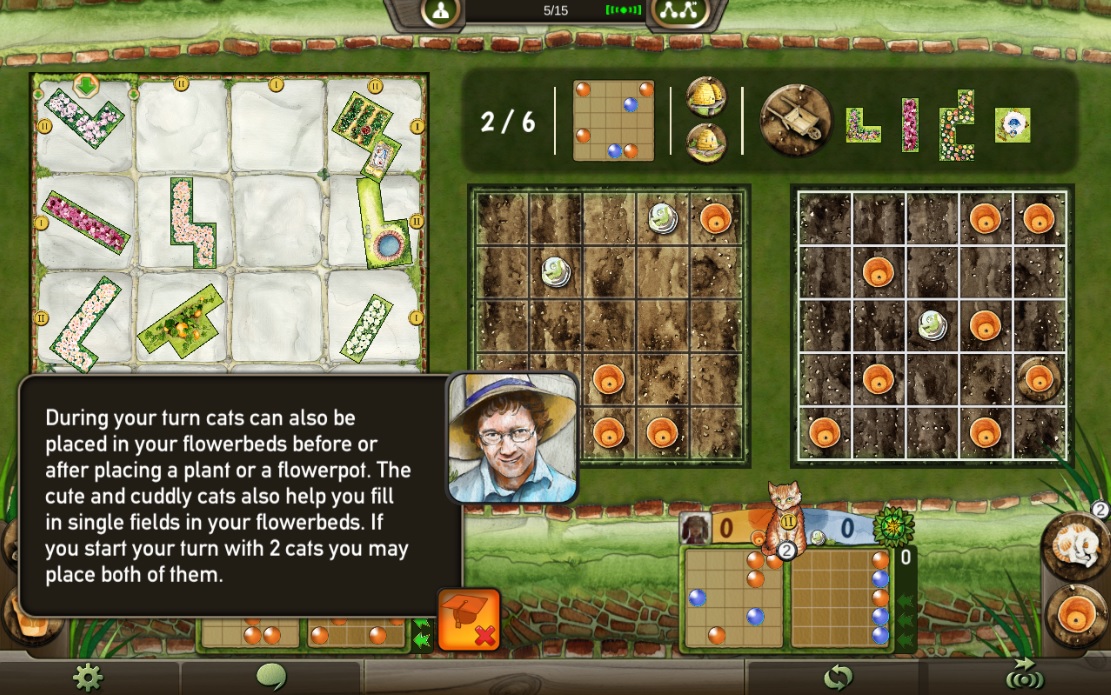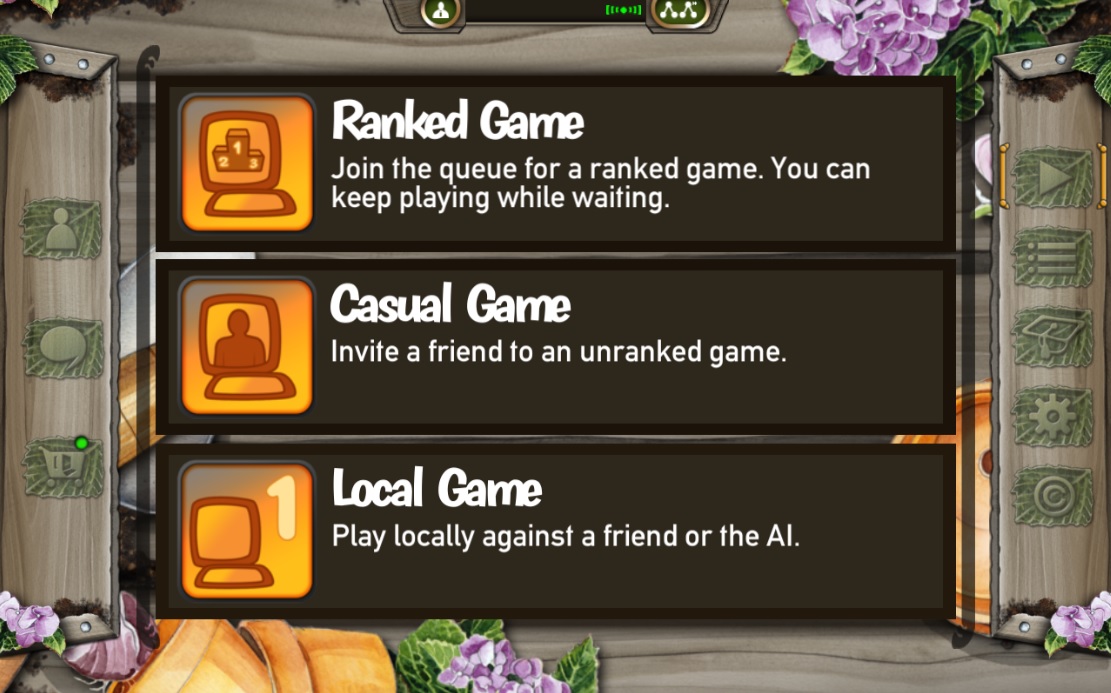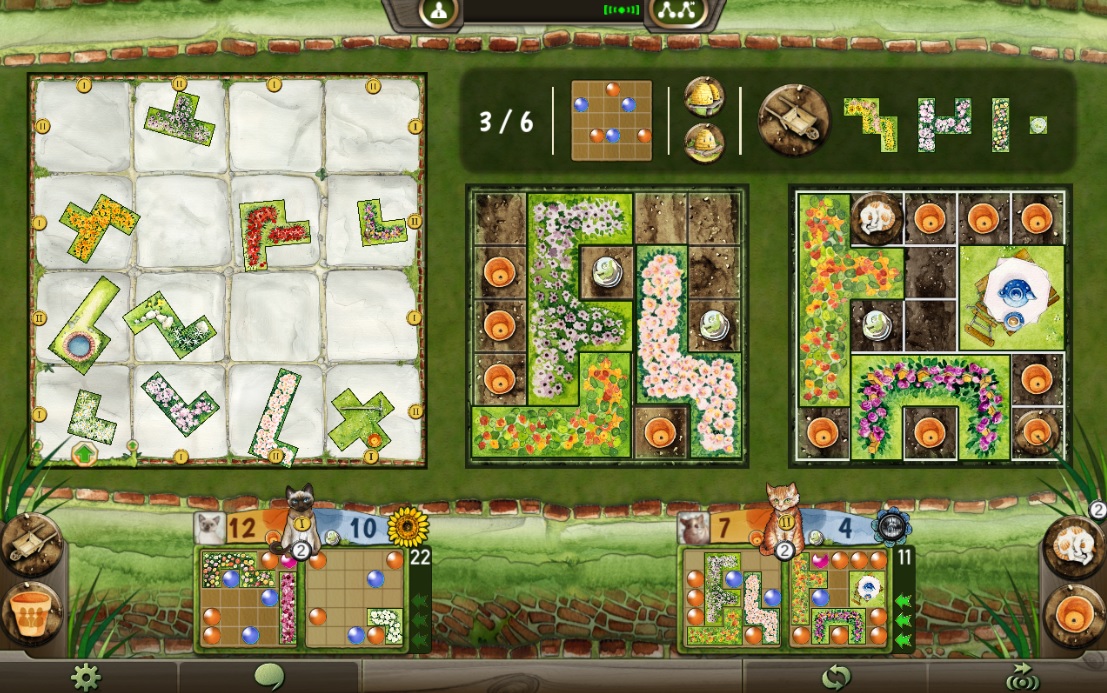![]() As interest in board games continues to rise, so too does the interest in exploring new ways of playing those games. One such way is through digital ‘ports’ of those games – translating them PCs, consoles, phones, and tablets.
As interest in board games continues to rise, so too does the interest in exploring new ways of playing those games. One such way is through digital ‘ports’ of those games – translating them PCs, consoles, phones, and tablets.
While digital versions may not exactly replace the feeling of a physical board game, many add subtle tweaks that such as for solo play, campaign modes, online competition, or simply as a more portable way to enjoy the game. This is new territory to explore. Welcome, to the Pixel Provinces.
![]()
From the moment Cottage Garden released it had players eagerly puzzling their way to a beautiful garden, but does that horticultural enjoyment fare as well when digitally adapted?
The Game
In many ways, Cottage Garden is the spiritual successor to Uwe Rosenberg’s 2014 release Patchwork, where players were tasked with creating beautiful patchwork quilts out of polyomino tiles. Cottage Garden takes that puzzle game core and shifts its focus onto gardening by transforming the tiles into beautiful flower beds. Players plant those tiles on their garden boards to fill them up while avoiding planting over their flower pots and cloches. The goal of the game is to have the most points from your completed gardens by the end of the final round.
Tutorial
Completing the tutorial isn’t required when you first load up the game, but it can be helpful to new and returning Cottage Garden players. Due to space constraints, pieces from the physical game are condensed and rearranged in this adaptation, so the difference in board layout can be tricky at first if you’re used to playing the tabletop game. Walking through the tutorial gives experienced players a chance to get accustomed to the new digital landscape. The tutorial is also extremely helpful to those having their first experience with Cottage Garden, as it takes care to walk you through all the details.
The tutorial is broken up into sections, which keeps it from being overwhelming to new players. The rules are explained clearly and concisely, and you are given plenty of examples to ensure that you have a solid grasp on the rules before beginning to play. The tutorial sections can be revisited in any order and a link to a video tutorial of the physical game is included. This added resource is especially helpful to players who may be unsure of some of the game’s more complex aspects, such as scoring.
Gameplay Features
Cottage Garden’s puzzle and strategy based gameplay transfer well to a digital adaptation. The transitions between player turns are quick, clear, and don’t detract from the flow of the game. Additionally, background animations of ladybugs and mice are added to the original artwork and stylistic choices, providing a pleasant atmosphere and making this adaptation feel truly representative of its physical version.
The game comes with both online and local play options. Local mode offers AI that comes in three difficulty levels, as well as a pass and play option for playing with local friends. AI players can easily be added into a pass and play game if you’re looking to increase the player count, but they also make for good opponents in a solo game. However, AI players begin to lag the longer you play and can leave you waiting a few minutes between turns while they load their moves, which disrupts the flow of the game and makes playing against multiple AI players less appealing.
The online mode has both ranked and fast play games, and gives you the option to play quick, unranked games while you wait to be matched up for a ranked game. The online mode also has a personal statistics record, which is handy for players that want to log their plays and track their success rate. However, if you’re looking for a swift game session, you’ll have more luck playing against the AI in local mode. While online games are possible, the low online player count makes it difficult to be matched with someone immediately. That said, if you’re looking for a longer game to play as you go about your day, ranked games are a good choice and are made better by the asynchronous turn option. Asynchronous turns are also helpful in casual games where you can invite friends to play online.
Functionality
Reflecting the original game’s components, there are a lot of pieces floating around in Cottage Garden, but the digital adaptation does a good job at keeping all the information visible and ordered despite its harsh size constraint. The garden boards are presented clearly beside the nursery, the board that displays the available tiles, and smaller representations of all players’ boards are provided at the bottom of the screen. These boards make it easy to keep track of the state of the game without detracting from your own tableau space, and while only four future tiles are visible on the main screen, you always have the option of toggling between the full selection of tiles and other players’ boards. The nursery also lists each player number next to the individual columns and rows, which proves helpful when trying to plan which tiles to take on future turns.
The drag and drop tiles and simple rotation options makes the interface easy to grasp, which lets you focus on enjoying the game. However, the simplicity of this system is regrettably hindered by the habitual unresponsiveness of the tiles. Tiles, cats, and pots are frequently unresponsive and difficult to drag into place due to the precision required for placement. This problem is emphasized by the garden boards’ small size, which requires precise placement for smooth game flow. This is especially true for phone screens, but playing on larger tablet screens only partially helps.
Luckily, Cottage Garden includes an undo button and requires you to confirm your turn twice before it moves to the next player. This feature gives you the option to change your mind if you feel you should’ve played your turn differently, and provides a much-needed safety net in case unresponsive tiles interfere with your turn, making its issues more of an inconvenience to playing rather than being outright prohibitive.
Verdict
Complete with plenty of beehives and cats, Cottage Garden is every bit as fun as its tabletop predecessor. The game’s size constraint and need for strict tile placement results in a finicky drag and drop system, but online and local modes allow for plenty of gameplay options with mechanics adapted seamlessly from the physical game. Most importantly, the game’s puzzle-based core identity holds up well to digital adaptation while retaining the original experience that made Cottage Garden so appealing in the first place.
Cottage Garden is available for Apple iOS and Google Android
![]()
Sara Perry is a contributing writer and aspiring game designer with a love for games both physical and digital. Also cats. She can be best reached via Twitter.
Feel free to share your thoughts with us over on our social media pages!



